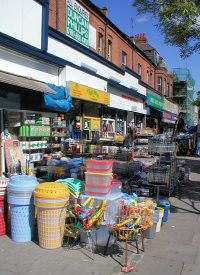Seven Sisters
Seven Sisters, Haringey
A poor, multi-ethnic neighbourhood encircling the junction of Seven Sisters Road and the High Road in South Tottenham

It is said that sometime around 1350 seven elm trees were planted in a ring around a walnut tree by the roadside at Page Green by seven sisters when they were about to go their separate ways. A Protestant martyr was later supposed to have been burnt here, after which the walnut tree flourished without growing bigger. Although there’s almost no doubt that parts of this story are mythical, the trees certainly existed in the 17th and 18th centuries. The walnut had died by 1790 but the elms lasted long enough to give their name to a turnpike road built in 1833 to provide improved access from Tottenham to Westminster.
Seven Sisters Road became a ribbon development of large villas, some with gardens backing onto the New River. The elms were removed around 1840, although the seven daughters of a Tottenham butcher later planted a new set, which has not survived.
Seven Sisters station opened on the Great Eastern Railway in 1872, rapidly bringing two-storey terraced houses to newly built streets in place of an earlier scattering of middle-class villas.
Many of the Victorian properties were allowed to deteriorate during the first half of the 20th century and some were cleared after the Second World War.
Seven Sisters station became a Victoria Line interchange in 1968 and over the following decade Haringey council built several small estates of low-rise flats. The low-rent shops in the vicinity of the station entrances bear witness to the deprivation of this corner of the borough, although the presence of that station has pushed up house prices.
At the 2011 census, 29 per cent of residents were white British and 20 per cent were black or black British. Both these figures represented declines on 2001, with this multi-ethnic locality becoming even more diverse. Poles and Turks rank high among Seven Sisters’ other significant minorities.
At Seven Sisters primary school on South Grove the majority of pupils are from minority ethnic groups. According to Ofsted’s 2016 report, they are mainly from Turkish, Caribbean and black African heritages and the proportion speaking English as an additional language is above average.
